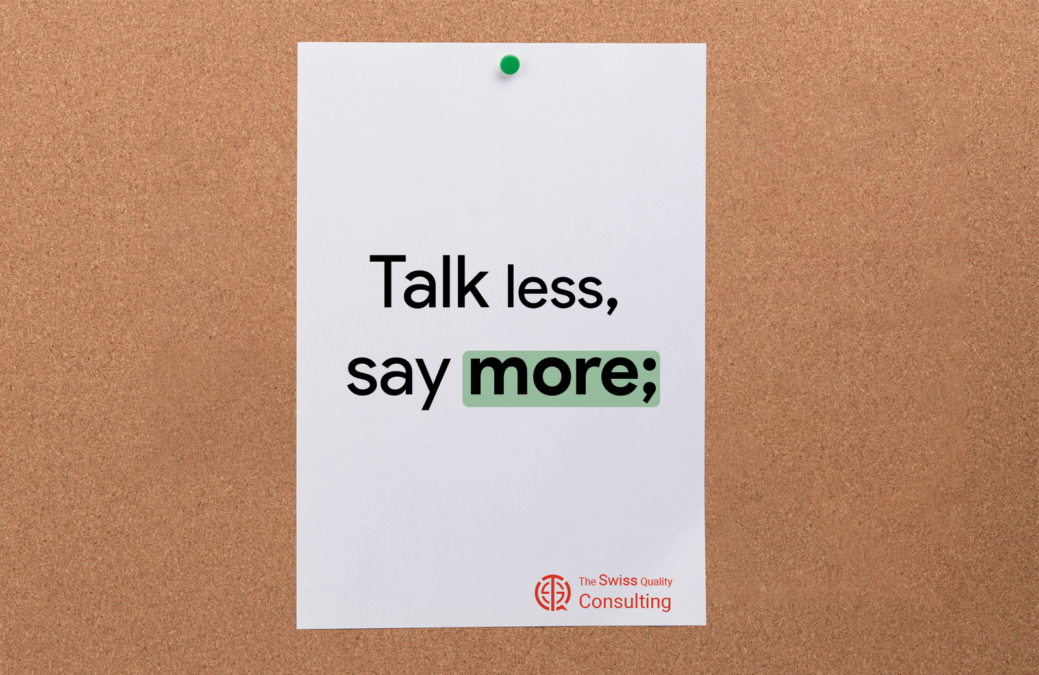The Art of Effective Communication: Talk Less, Say More
In today’s fast-paced and information-saturated world, the age-old wisdom of “talk less, say more” has never been more relevant. Effective communication is a skill that can transcend boundaries and foster connections between people from diverse backgrounds. It allows us to express our thoughts, ideas, and emotions with clarity and precision. In this text, we will explore the significance of this simple yet powerful principle and how it can improve our personal and professional lives.
The Power of Conciseness:
Communication is not just about the quantity of words we use but the quality of those words. One of the fundamental aspects of effective communication is conciseness. When we talk less, we have the opportunity to choose our words thoughtfully, ensuring that each word carries significant meaning.
Consider a business presentation where a concise and impactful message captures the audience’s attention far better than a long and rambling one. Or think about a conversation with a friend where a few carefully chosen words convey empathy and support more effectively than a lengthy monologue. In both scenarios, talking less and saying more allows us to create a stronger and more lasting impact.
Active Listening:
Effective communication is a two-way process. It’s not just about what we say but also how well we listen. Active listening is a crucial component of this process. When we talk less, we create space for others to express their thoughts and feelings. This not only promotes better understanding but also makes the other person feel valued and heard.
In personal relationships, active listening can lead to deeper connections and stronger bonds. It enables us to empathize with the other person’s perspective and respond thoughtfully. In professional settings, active listening can enhance collaboration and problem-solving.
Avoiding Misunderstandings:
Excessive talking can often lead to misunderstandings. When we overwhelm others with information or meander off-topic, we risk diluting our intended message. Conversely, talking less ensures that our message remains clear and focused, reducing the chance of misinterpretation.
In today’s digital age, where written communication is predominant, the same principle holds true. Clear and concise emails, text messages, and social media posts are more likely to be understood and appreciated than lengthy ones. By adhering to the principle of “talk less, say more,” we can sidestep unnecessary confusion and miscommunication.
Making an Impact:
Think about the most memorable speeches or presentations you’ve encountered. Chances are, they were not filled with endless words but rather with powerful and well-constructed sentences. When we talk less, we have the opportunity to make a lasting impact with our words.
In the realm of public speaking, renowned orators like Martin Luther King Jr. and Winston Churchill are celebrated for their ability to deliver concise and impactful speeches that resonated with millions. Their words were carefully chosen and delivered with conviction, leaving an indelible mark on history.
The Role of Nonverbal Communication:
Effective communication extends beyond verbal language. Nonverbal cues such as body language, facial expressions, and tone of voice play a significant role in conveying our message. When we talk less, we can concentrate on these nonverbal elements, enhancing our ability to connect with others.
For instance, maintaining eye contact during a conversation can convey sincerity and attentiveness. A warm smile can make the other person feel comfortable and appreciated. By talking less and paying attention to these nonverbal cues, we can strengthen the impact of our communication.
Building Trust and Respect:
When we talk less, we demonstrate respect for others’ time and attention. In a world where distractions abound, showing consideration for others’ schedules and priorities can go a long way in building trust and respect.
In professional settings, respecting colleagues’ time by keeping meetings concise and to the point can lead to greater efficiency and collaboration. In personal relationships, valuing someone’s time by being present and engaged in the moment can strengthen the bond between individuals.
The principle of “talk less, say more” is a timeless guide to effective communication. Embracing conciseness, active listening, and the power of nonverbal cues can enhance our ability to connect with others on a profound level. This approach not only reduces the risk of misunderstandings but also allows us to make a lasting impact with our words. Whether in personal or professional contexts, effective communication is a valuable skill that can lead to stronger relationships and more successful interactions.
#EffectiveCommunication #Conciseness #ActiveListening #NonverbalCommunication #BuildingTrust












